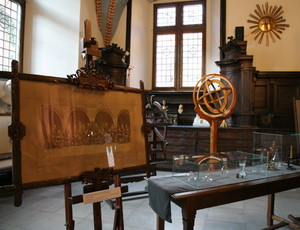
Exhibit of the Month is a series initiated by the Jagiellonian University Museum with the beginning of the new academic year. Each month we will explain the Museum collection to you, choosing a single exhibit or a group of exhibits which usually are not shown to the open public. This month's feature is a collection of objects related to the history of the Medical Faculty, including preparation instruments formerly owned by Professor Henryk Hoyer (physician, anatomist, histologist, JU professor, the founder of the Cracow school of zoology), microscopes and historical photographs.
Cracow’s Studium Generale, founded in 1364 and officially renamed to the Jagiellonian University in the 19th century, originally had three faculties: law, medicine, and liberal arts. The oldest source mentioning the Faculty of Medicine dates back to the early 15th century. It reports about the Galen’s lecture room located in the ground floor of Collegium Maius, a building that was under construction at that time and where lectures on medicine were held.
In 1428, a wooden building named Collegium Medicum (domo medicorum, or ‘house of physicians’) was constructed in the Okół area of Cracow, near the present-day Grodzka Street, and medical studies moved there. The college was destroyed by a fire together with all records and precious documents concerning the three centuries of history of the Medical Faculty. The 16th century brought a significant development of the university and its faculties. The medical university established new chairs, a formal programme and curriculum, and its financial stability was secured. Talented scholars and crowds of students were drawn to the Cracow university from numerous European countries. The age of Renaissance, marked by great achievements and development of the university, was followed by two centuries of crisis and stagnation. The university became financially and emotionally exhausted after a prolonged conflict with the Jesuit order over the right to control education in Poland. Therefore, Cracow’s scholars were unable to draw a modern teaching programme. Students and professors were abandoning the university and the institution was falling into ruin, following the general decline of the Polish-Lithuanian Commonwealth. Only in the late 18th century, as a result of the efforts undertaken by the Commission of National Education and reforms introduced by Hugo Kołłątaj, the university was revitalised. Kołłątaj’s plans for reforms, expansion and growth of the Cracow university were halted by the partitions of Poland. Austrian universities imposed their own order. The university’s autonomy was limited and government funding decreased while the language of instruction was forcibly changed to German.
Nevertheless, the second half of the 19th century, despite numerous restrictions imposed by the occupier, turned out to be a period of significant development for the Jagiellonian University’s Faculty of Medicine. During that time, it employed extraordinary lecturers and researchers who often gained an international renown. New clinical facilities were built at the Grzegórzecka and Kopernika streets, and the faculty built modern laboratories, and published several medical periodicals and textbooks.
The First World War stopped further development of the Faculty of Medicine. Professors were working in field hospitals, visited the frontlines to take care of wounded, organised mass vaccinations to prevent an outbreak of epidemics, and medical students were serving in the ranks of various armies. The equipment belonging to clinics and laboratories was scattered and destroyed.
The interwar period was a new period of laborious restoration and development of the university against many financial and political obstacles. New chairs were established, as well as a dormitory for medical students, and clinics, laboratories and other facilities received new, modern equipment. Renowned professors were responsible for the management of various chairs and clinics. Numerous conferences and symposiums were organised. The wide-ranging plans and projects concerning a further growth of the university and its medical faculty were ruined by the Second World war.
Many members of the faculty died in concentration camps while the German occupiers were destroying laboratories and seizing the equipment from clinics. The Jagiellonian University together with the Faculty of Medicine went into hiding, providing clandestine education for more than two hundred adepts of medicine and pharmacy.
Following the end of the war, the government decided to separate the Faculty of Medicine from its parent university. The Medical Academy was established as a separate educational and clinical entity. It was the beginning of another period of development and growth.
In 1993, the Medical Academy returned to the Jagiellonian University as the Collegium Medicum with its own four faculties and several chairs. Presently, it has about 6,500 students. The teaching staff consists of 150 professors and 450 medical doctors.

